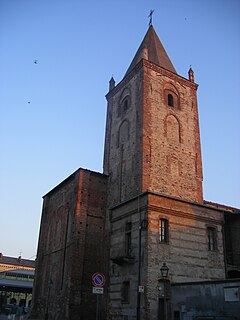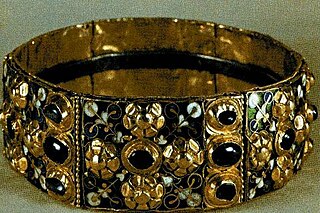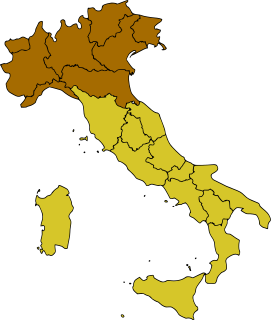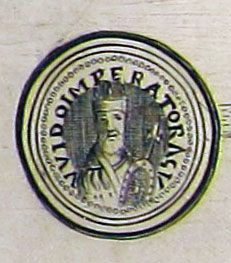Auriate was a county in medieval Italy on the eastern slopes of the Western Alps lying between Cuneo and Saluzzo. The county existed from the late ninth century to the middle of the tenth. The name of the county survives in that of the comune of Valloriate.

The Western Alps are the western part of the Alpine range including the southeastern part of France, the whole of Monaco, the northwestern part of Italy and the southwestern part of Switzerland. In the southeast the range is bounded by the Italian Padan Plain. In the west, the valley of the Rhone river separates it from the Massif Central. The northernmost part of the Western Alps - in the wide meaning of the term - is formed by the Swiss Prealps sub-range.

Cuneo is a city and comune in Piedmont, Northern Italy, the capital of the province of Cuneo, the third largest of Italy’s provinces by area.

Saluzzo is a town and former principality in the province of Cuneo, Piedmont region, Italy.
The earliest known count was one Rodulf, who died in 902, leaving the county to a Frank named Roger, who had been his second-in-command. Between 940 and 945 Roger's son and successor, Arduin Glaber, drove the Saracens from the Val di Susa and annexed that region to his county of Auriate. Arduin was a supporter of Berengar of Ivrea in his successful bid for the Iron Crown of Lombardy in 950. The following year (951) Berengar completed a reorganisation of western Lombardy, creating three new marches to better defend the coast from Saracen attacks: the March of Genoa (Eastern Liguria), the March of Montferrat (Western Liguria), and the March of Turin. Arduin was created the first Margrave of Turin.

The Franks were a collection of Germanic peoples, whose name was first mentioned in 3rd century Roman sources, associated with tribes on the Lower and Middle Rhine, on the edge of the Roman Empire. Later the term was associated with Romanized Germanic dynasties within the collapsing Roman Empire, who eventually commanded the whole region between the rivers Loire and Rhine. They then imposed power over many other post-Roman kingdoms and Germanic peoples, and still later they were given recognition by the Catholic Church as successors to the old rulers of the Western Roman Empire.
Arduin Glaber was count of Auriate from c. 935, count of Turin from c. 941/2, and Margrave of Turin from c. 950/64. He placed his dynasty, the Arduinici, on a firm foundation and established the march of Turin through conquests and royal concessions. The Chronicon Novaliciense, the chronicle of the abbey of Novalesa, is the primary source for his life.

Berengar II was the King of Italy from 950 until his deposition in 961. He was a scion of the Anscarid and Unruoching dynasties, and was named after his maternal grandfather, Berengar I. He succeeded his father as Margrave of Ivrea around 923, and after 940 led the aristocratic opposition to Kings Hugh and Lothair II. In 950 he succeeded the latter and had his son, Adalbert crowned as his co-ruler. In 952 he recognised the suzerainty of Otto I of Germany, but he later joined a revolt against him. In 960 he invaded the Papal States, and the next year his kingdom was conquered by Otto. Berengar remained at large until his surrender in 964. He died imprisoned in Germany two years later.
At this time Auriate disappears from the records as a distinct entity, but it remained the centre of the property of the Arduinici family three generations later, when Bertha married Ottone del Vasto of the Aleramici clan. Their joint properties formed the nucleus of the later March of Saluzzo.
The Arduinici were a noble Frankish family that immigrated to Italy in the early tenth century, possibly from Neustria. They were descended from and take their name after one Arduin (Harduoin).

The Aleramici were a medieval Italian noble family of Frankish origin which ruled various northwestern counties and marches, in Piedmont and Liguria from the tenth to the 14th century.








